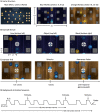An adversarial collaboration protocol for testing contrasting predictions of global neuronal workspace and integrated information theory
- PMID: 36763595
- PMCID: PMC9916582
- DOI: 10.1371/journal.pone.0268577
An adversarial collaboration protocol for testing contrasting predictions of global neuronal workspace and integrated information theory
Abstract
The relationship between conscious experience and brain activity has intrigued scientists and philosophers for centuries. In the last decades, several theories have suggested different accounts for these relationships. These theories have developed in parallel, with little to no cross-talk among them. To advance research on consciousness, we established an adversarial collaboration between proponents of two of the major theories in the field, Global Neuronal Workspace and Integrated Information Theory. Together, we devised and preregistered two experiments that test contrasting predictions of these theories concerning the location and timing of correlates of visual consciousness, which have been endorsed by the theories' proponents. Predicted outcomes should either support, refute, or challenge these theories. Six theory-impartial laboratories will follow the study protocol specified here, using three complementary methods: Functional Magnetic Resonance Imaging (fMRI), Magneto-Electroencephalography (M-EEG), and intracranial electroencephalography (iEEG). The study protocol will include built-in replications, both between labs and within datasets. Through this ambitious undertaking, we hope to provide decisive evidence in favor or against the two theories and clarify the footprints of conscious visual perception in the human brain, while also providing an innovative model of large-scale, collaborative, and open science practice.
Copyright: © 2023 Melloni et al. This is an open access article distributed under the terms of the Creative Commons Attribution License, which permits unrestricted use, distribution, and reproduction in any medium, provided the original author and source are credited.
Conflict of interest statement
The authors have declared that no competing interests exist.
Figures




References
-
- Crick F., The astonishing hypothesis: the scientific search for the soul. 1994, New York: C. Scribner.
-
- Chalmers D.J., The problems of consciousness. Adv Neurol, 1998. 77: p. 7–16; discussion 16–8. - PubMed
-
- Weiskrantz L., Consciousness lost and found: A neuropsychological exploration. 1999, New York: Oxford University Press.
-
- Koch C., The Feeling of Life Itself: Why Consciousness Is Widespread but Can’t Be Computed. 2019, Cambridge: MIT Press.
Publication types
MeSH terms
Grants and funding
LinkOut - more resources
Full Text Sources

